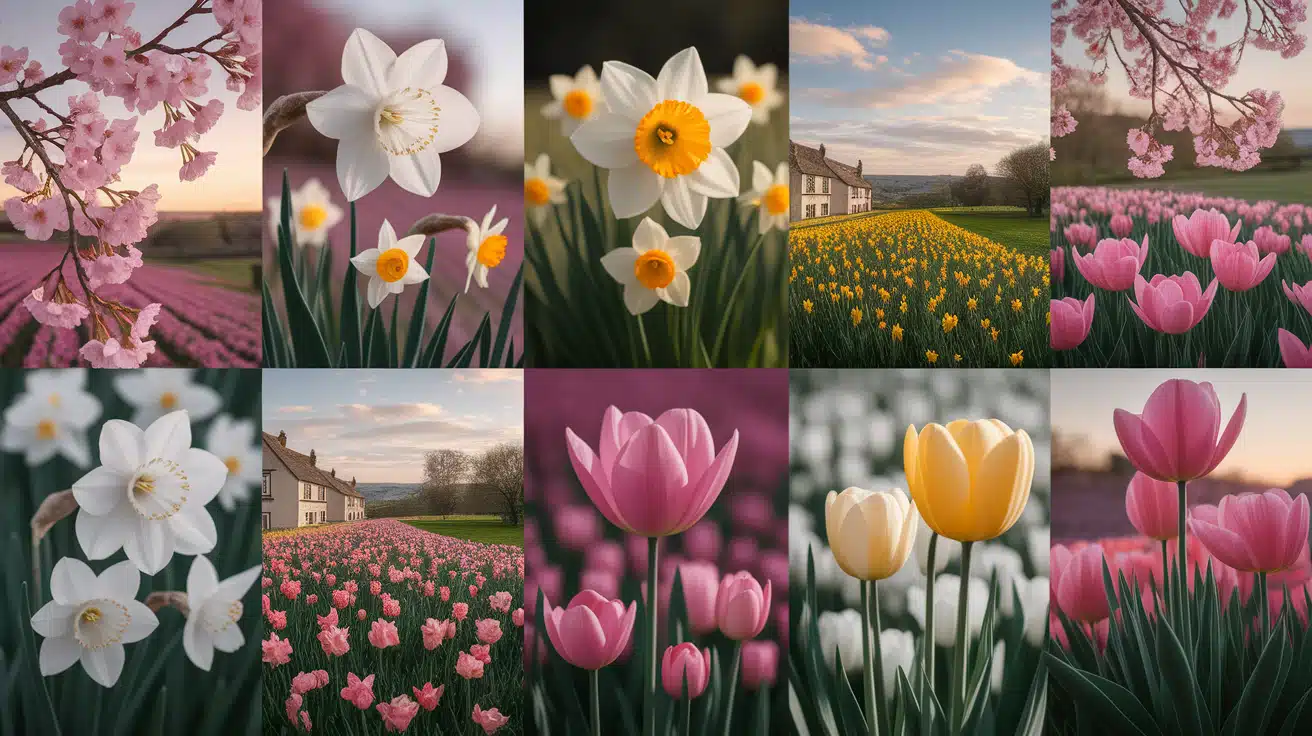Spring brings a spectacular display of colours across Britain’s countryside and gardens, from woodland carpets of bluebells to delicate primroses peeking through hedgerows.
Close your eyes. Can you smell wallflowers’ sweet perfume drifting over old stone walls? Hear the gentle buzz of bees diving into bluebell carpets? April changes Britain into a living masterpiece.
While others rush past with their heads down, flower hunters know the secret. This month holds treasures hiding in plain sight.
Snake ‘s-head fritillaries nod in ancient meadows. Violet-scented pathways wind through forgotten corners, and woodland floors shimmer with white anemone stars.
Some blooms last just days. Others have waited centuries for this moment. Every hedgerow tells stories. Every garden corner whispers promises.
Ready to become a flower detective? Here are April bloomers that will change how you see spring forever.
Why Are the UK’s April Flowers Special?
April marks Britain’s true spring awakening, when perfect conditions create the year’s most spectacular floral display. After long, grey winters, this month brings pure hope and renewal through fleeting moments of beauty that won’t return for another year.
What Makes April Flowers So Remarkable
- Ancient woodlands come alive – Bluebells carpet forest floors in spectacular displays.
- Garden favorites shine – Cheerful daffodils brighten every corner.
- Rare wildflowers emerge – Snake ‘s-head fritillaries bloom in select locations.
- Incredible diversity appears – From delicate wood anemones that open only in sunshine to fragrant wallflowers perfuming old stone walls.
- Wildlife depends on timing – Hungry bees emerge while orange-tip butterflies rely on cuckoo flowers for survival.
- Perfect conditions align – Weather, daylight, and plant cycles create ideal blooming moments.
21 Beautiful April Flowers to Spot in the UK
Find the charm of spring with this guide to 21 gorgeous April-blooming flowers across the UK, complete with scientific names, heights, and where to find them in the wild.
1. Primrose

Cheerful yellow blooms brighten hedgerows and woodland edges throughout the month of April. These hardy perennials thrive in partial shade and moist, well-drained soil. Their pale yellow petals create gorgeous natural carpets beneath trees.
Key Details
- Scientific name: Primula vulgaris
- Height: 20cm
- Folklore: Traditional fairy flowers
2. Sweet Violet

These tiny purple treasures hide in shady corners with an unmistakable sweet fragrance. You’ll catch their scent before you see them. Sweet violets prefer cool, damp spots, such as under shrubs or along north-facing walls. Their heart-shaped leaves make them easily identifiable.
Key Details
- Scientific name: Viola odorata
- Height: 10cm maximum
- Historical use: Natural perfume ingredient
3. Wood Anemone

White star-shaped flowers carpet ancient woodland floors in April. Growing 15cm tall, these indicate old forests since they spread slowly over decades. Delicate petals open only in sunshine. These blooms mark truly wild spaces.
Key Details
- Scientific name: Anemone nemorosa
- Location: Ancient woodland only
- Behaviour: Closes in shade/evening
4. Bluebell

Britain’s native bluebells create stunning displays that reach 50cm in height. These bulbs buzz with visiting bees collecting nectar. True British bluebells have narrow leaves and drooping flower heads.
Key Details
- Scientific name: Hyacinthoides non-scripta
- Location: Ancient woodlands
- Threat: Spanish bluebell invasion
5. Snake’s-Head Fritillary

Checkered purple bells stand 35cm tall in flood meadows. Unusual spotted pattern resembles snakeskin, inspiring the common name. These rare wildflowers need wet winters and dry summers. Only a few British sites still support wild populations.
Key Details
- Scientific name: Fritillaria meleagris
- Location: Traditional flood meadows
- Status: Vulnerable species
6. Lesser Celandine

Bright yellow stars open in woodland edges, staying low at 10cm. Glossy petals shine like butter in spring sunshine. Heart-shaped leaves emerge before flowers. Plants disappear completely by storing energy underground for next year’s display.
Key Details
- Scientific name: Ficaria verna
- Location: Woodland edges
- Habit: Summer dormant
7. Early Purple Orchid

Elegant purple spikes stand 30cm tall in grasslands throughout April. Deep purple flowers attract butterflies and long-tongued bees. Each plant can live for decades, producing more flowers with age.
Key Details
- Scientific name: Orchis mascula
- Location: Alkaline grassland
- Lifespan: Several decades
8. Bugle

Blue flower spikes reach 15cm high in damp woodlands. Plants spread via underground runners, forming patches of deep blue. Ground beetles and insects shelter under evergreen leaves through winter.
Key Details
- Scientific name: Ajuga reptans
- Location: Damp woodland
- Family: Mint (square stems)
9. Cuckooflower

Pink, cross-shaped flowers nod in damp meadows, standing 20 cm tall. It blooms when cuckoos return to Britain. Orange-tip butterflies lay eggs exclusively on these plants. Four-petaled flowers form perfect crosses.
Key Details
- Scientific name: Cardamine pratensis
- Alternative name: Lady’s Smock
- Butterfly host: Orange-tip exclusive
10. Violet Wood Sorrel

White flowers with purple veins appear in shady forests, reaching 10cm high. Shamrock-shaped leaves fold down at night and in the rain.
Key Details
- Scientific name: Oxalis acetosella
- Leaves: Three-leaflet shamrock
- Taste: Lemony, mildly acidic
11. Forget-Me-Not

Tiny blue flowers with yellow centres appear along borders and paths, growing 20cm tall. These annuals self-seed freely, popping up in unexpected places. Garden varieties typically bloom longer than their wild counterparts.
Key Details
- Scientific name: Myosotis sylvatica
- Habit: Self-seeding annual
- Origin: Medieval symbolism
12. Wallflower

Orange blooms release intense fragrance on warm April days, reaching 50cm in sunny spots. Modern garden varieties come in many colours, but wild ones stay orange or yellow.
Key Details
- Scientific name: Erysimum cheiri
- Origin: Mediterranean
- Wild colours: Orange and yellow
13. Lungwort

Spotted-leaf plants grow 35cm tall in shaded areas. Speckled leaves are said to resemble diseased lungs, leading to their historical medicinal use. Bees value the early nectar when few other flowers are available.
Key Details
- Scientific name: Pulmonaria officinalis
- Flower change: Pink to blue
- Historical use: Medicinal plant
14. Hellebore

Cup-shaped flowers appear on 45cm plants in woodland borders. Christmas roses and Lenten roses bloom from winter into spring. Tough evergreen leaves provide year-round structure. These perennials live for decades, slowly forming large clumps.
Key Details
- Scientific name: Helleborus spp.
- Season: Winter through spring
- Warning: All parts are toxic
15. Reticulate Iris

Miniature irises reach 15cm high in rockeries and containers. Netted bulb coats give them their scientific name. Intense blue flowers appear before leaves fully develop.
Key Details
- Scientific name: Iris reticulata
- Needs: Excellent drainage, hot summers
- Uses: Rockeries, containers
16. Winter Aconite

Golden cup-shaped flowers push through late winter soil. Green bract collar surrounds bright yellow blooms. These bulbs naturalise under deciduous trees, forming golden carpets.
Key Details
- Scientific name: Eranthis hyemalis
- Height: 10cm
- Planting tip: Use fresh bulbs
17. Camellia

Rose-like blooms appear on evergreen shrubs in April gardens. Glossy dark leaves provide a perfect backdrop for pink, red, or white flowers. These acid-loving plants need shelter from cold winds. Some varieties bloom from winter through spring.
Key Details
- Scientific name: Camellia spp.
- Type: Large evergreen shrub
- Protection: Shelter from wind
18. Pieris

Bell-shaped flower clusters droop from evergreen shrubs in acid gardens. White, pink, or red panicles last for weeks. Young leaves often emerge bronze or red, adding extra colour. These plants need consistent moisture and acidic soil.
Key Details
- Scientific name: Pieris spp.
- Flowers: Drooping bell clusters
- New growth: Often bronze/red
19. Tulip

Classic cup-shaped flowers celebrate spring in countless colours. Some species of tulips naturalise in grass, returning yearly without replanting. Darwin hybrids provide the best perennial performance in British gardens.
Key Details
- Scientific name: Tulipa spp.
- Height range: 15-60cm
- Naturalising: Species types spread
20. Narcissi/Daffodils

Cheerful yellow trumpets welcome spring. From tiny species to large garden varieties, they suit every space. Most types naturalise well in grass or borders. Toxic bulbs protect them from rodent damage naturally.
Key Details
- Scientific name: Narcissus spp.
- Height range: 25-40cm
- Naturalising: Most spread well
21. Grape Hyacinth

Tiny blue spikes carpet spring borders. Dense clusters of bell-shaped flowers resemble miniature grapes. These bulbs multiply rapidly, forming large colonies. Grassy leaves appear in autumn and persist through the winter months.
Key Details
- Scientific name: Muscari armeniacum
- Height: 20cm
- Appearance: Miniature grape clusters
Climate Impact: How April Blooms Are Shifting
Warmer UK winters are changing the timing of when April flowers bloom each year. Many spring bulbs now flower 2-3 weeks earlier than they did 20 years ago. Daffodils often peak in March instead of April, while some cherry trees bloom twice in mild years.
To adapt your garden, plant a mix of early and late spring varieties for longer colour displays. Choose heat-tolerant flowers, such as wallflowers and forget-me-nots, that are better suited to cope with unpredictable weather.
Keep detailed records of bloom times in your garden to track changes in your local area and plan future plantings accordingly.
April Flower Highlights & Meaning
| Category | Insight |
|---|---|
| Seasonal Magic | April flowers bring vibrant colour, fragrance, and early pollinator activity. |
| Hidden Treasures | Many blooms, such as wood anemones or fritillaries, only appear in specific, often ancient habitats. |
| Wildlife Connections | Some flowers support butterflies (e.g., cuckooflower for orange-tips), bees, and beetles. |
| Folklore & History | Violets, primroses, and lungwort carry centuries of tradition and symbolic meaning. |
| Gardening Tip | Blend early and late bloomers to stretch your spring display amid a changing climate. |
| Conservation Note | Native species like British bluebells and fritillaries face threats; knowing them helps protect them. |
Conclusion
April changes British gardens and countryside into living galleries of colour and fragrance. From reliable spring bulbs like daffodils and tulips to wild bluebells carpeting woodland floors, this month offers nature’s finest display.
These flowers prove that spring gardening can work for everyone, whether you prefer formal borders, cottage garden charm, or natural wild spaces.
Don’t just read about these beautiful blooms. Visit your local RHS garden, Learn about National Trust estates, or take woodland walks to see them firsthand. Plan your garden for next year by noting which flowers catch your eye.
What April flowers have you spotted in your area? Share your spring garden photos and discoveries, every flower tells the story of Britain’s awakening season.














